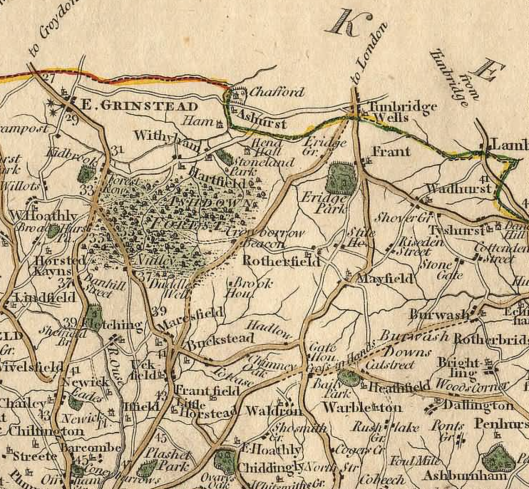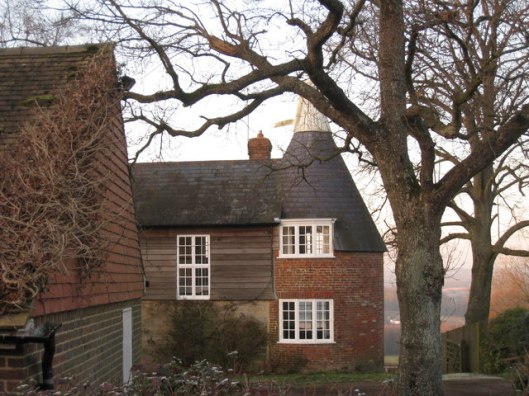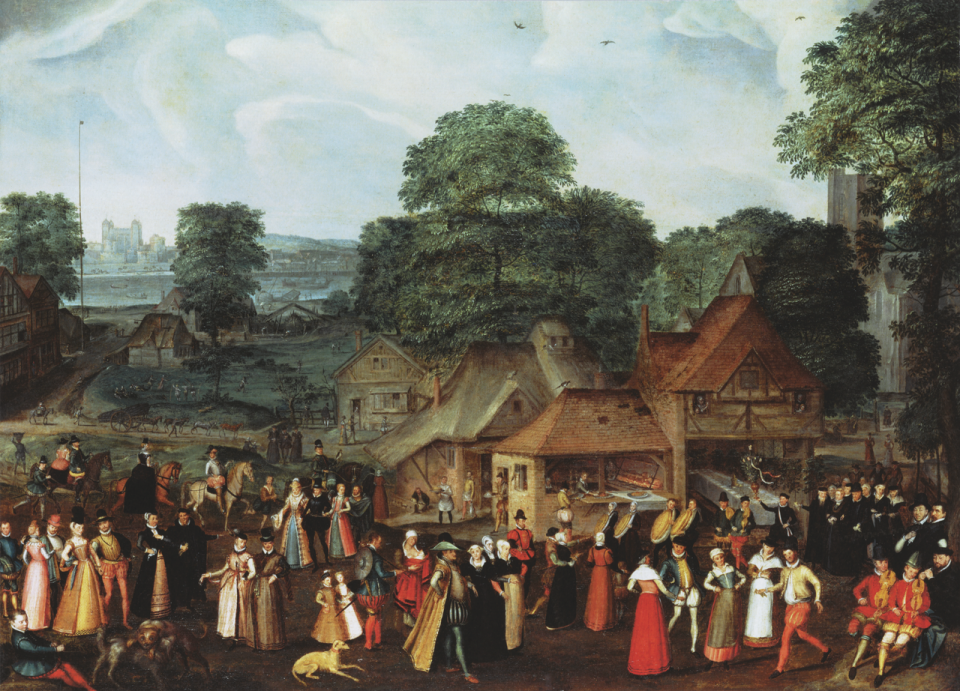Our story begins with three brothers. John, Richard and William Byne were born in the early years of the sixteenth century in the village of Burwash, in east Sussex, and evidence from later records leads us to conclude that they were brothers. William Byne was my 12th great grandfather.

Part of John Cary’s 1787 map of Sussex
The names of John, Richard and William Byne’s parents are not known, though the Lay Subsidy Rolls for 1524-5 list a Thomas Byne, taxed at £12, and a John Byne, taxed at £5, in the hundred of Hawkesburgh, which included Burwash. One of these men may have been the father of John, Richard and William, and it’s almost certain that he was, like them, a yeoman: in other words, a farmer who owned his own land, but was neither wealthy enough to be considered a member of the landed gentry, nor so poor that he was counted as a mere husbandman. All three Byne brothers would own their own property, in and around Burwash, which was in all probability inherited from their father.
Without accurate records of their births or baptisms, it’s difficult to determine which of the three brothers was the eldest, though it would appear from the dates of his marriage and death that Richard was probably the youngest.
John Byne
John Byne was probably born in the first decade of the sixteenth century, in the closing years of the reign of Henry VII, who died in 1509. According to Walter Charles Renshaw’s history of the family, in 1534 a John Byne was fined two pence for ‘cutting down trees and upsetting the King’s highway and filling up a ditch’. In 1549 John was assessed at Burwash to the Lay Subsidy, then levied at 13 shillings on £13 in goods. John married a woman named Joan, some time around the year 1530. They had four children: Symon, Henry, Richard and Joan. John Byne made his will on 27th November 1559, in the first year of the reign of Elizabeth I, appointing his brother Richard as overseer, and he was buried at Burwash two days later.
John and Joan Byne’s son Richard died two years after his father and was buried at Burwash on 16th April 1561.

St Bartholomew’s Church, Burwash
© Copyright Oast House Archive and licensed for reuse under a Creative Commons Licence (via geographic.org.uk)
Symon Byne married a woman named Joan, probably in the 1550s. They had two children: Margaret or Margery, and Richard, who was christened on 20th August 1559. Symon made his will on 20th December 1560, appointing his brother Henry as executor.
Henry Byne was married twice. His first wife was Margery: they probably married in about 1560. They had two children, Henry and William. Margery died in 1576. Henry’s second wife was Elinor Cruttenden, whom he married on 2nd December 1577 at Burwash. Henry Byne senior made his will on 2nd April 1578 and was buried six days later at Burwash.
John and Joan Byne’s daughter Joan was married twice. Her first husband was Goddard, another member of the Cruttenden family, who died in 1575, appointing his brother-in-law Henry Byne as overseer of his will. They had two children, Goddard and John. Joan’s second husband was Thomas Barham, whom she married at Burwash on 15th October 1576.
Richard Byne
Richard Byne was probably born in the second decade of the sixteenth century, during the early years of the reign of Henry VIII. He married a woman named Gillian, perhaps in the early 1540s. They lived at Witherden farm in Ticehurst, about five miles from Burwash, where Richard was assessed, first on £16 and then on £13, in goods, at 16 and 13 shillings respectively, to the Lay Subsidy levied in 1549 and 1552, of which he was also a ‘pettye collector’. He purchased land in Burwash from Henry Merry in 1566 and his will refers to ‘my newe howse’ there. Richard and Gillian Byne had five children: John, Thomas, Anne, Odiane and Margaret. Richard Byne made his will on 8th April 1574, appointing his ‘cosin’ (i.e. nephew, son of his brother John) Henry Byne as overseer, and it was proved on 13th May in the same year. Gillian Byne was buried at Burwash on 20th February 1581.
John, the son of Richard Byne, married Dionysia Pudland, the daughter of Richard Pudland of Heathfield, at Burwash on 10th July 1569. According to John’s will of 25th January 1580, he lived at Witherden, which he must have inherited from his father Richard. John and Dionysia Byne had two children: Mary, and an unnamed child baptised at Burwash on 10th April 1574 and buried there on 18th May in the same year. John Byne’s will, proved on 10th May 1581, makes reference to two of my direct ancestors: his first cousin, my 11th great grandfather, Edward Byne, and his father-in-law Magnus Fowle of Mayfield, who was one of the witnesses to the will.

Countryside near Burwash (via bandbchurchhouse.co.uk)
Richard Byne’s son Thomas was probably born in the early 1540s in Ticehurst. There is a record of a marriage between Thomas Byne and Agnes Stephen in Ticehurst on 13th June 1563, but the name of Thomas’ wife by the time he made his will in 1588 (in which he appointed Edward Byne as one of its overseers) was Amy. Thomas Byne and his wife (or wives) had eight children: Lawrence, Thomas, John, Peter, Joseph, Margaret, Elizabeth and Mary. Thomas Byne senior was buried at Burwash on 23rd November 1588. Amy Byne made her will on 16th January 1616, appointing her late husband’s nephew – and my 10th great grandfather -Stephen Byne, whose story will be told in a later post, as one of the overseers.
Richard Byne’s daughter Anne was probably born in the 1540s. She married a man with the surname Gardiner. As for Richard’s other daughters Odiane and Margaret, they were probably born in the early 1550s, but what became of them after that is not known.
William Byne
My 12th great grandfather William Byne was almost certainly born, like his brother John, in the first decade of the sixteenth century. According to Renshaw, by a lease dated 19th November 1538, Thomas Taylor, then Abbot of the Cistercian Abbey at Robertsbridge, five miles or so from Burwash, demised a tenement or piece of land in Burwash known as ‘Witteres’ to William Byne for twenty-one years from Lady Day 1539, for the yearly rent of 23s 4d.

Oast House at Witherhurst, Heathfield Road, Burwash, East Sussex © Copyright Oast House Archive and licensed for reuse under a Creative Commons Licence (via geograph.org.uk)
However, according to another source, the abbey, having escaped the first wave of Henry VIII’s suppression of the monasteries, was surrendered to the Crown by Thomas Taylor on 16th April 1538. The dates are difficult to reconcile, and one of the sources must be mistaken. It seems most likely that the abbey leased the property to my ancestor in the November before its suppression. Witteres was, I believe, identical with Witherhurst Farm, which still survives in Burwash, just off the main A265 Heathfield Road heading west out of the village, and less than a mile from Bateman’s, the house that would later be home to Rudyard Kipling.
William Byne was assessed on £10 in goods on 10 shillings to the Lay Subsidy levied in 1549 and 1551/2 in the Hundred of Hawksborough, which includes Burwash, and also in the Borough of Possingworth. In 1550 he bought land in Burwash from a certain J. Segar.
William Byne married his wife, Joan, in about 1530. They had five children who survived them: Margaret or Margery, Anthony, Symon, Jane – and my 11th great grandfather Edward Byne. William made his will on 16th April 1557, in the last months of the reign of Mary Tudor, and he was buried at Burwash on 28th August 1559. He appointed his wife Joan and Richard Barham to be executors of his will, and his brother John as its overseer, but in the event the latter only outlived him by a few months. William’s wife Joan made her will on 20th May 1567 and was buried on 31st July 1575.
In his will William Byne left properties called ‘Upper Croft’, ‘Colth'(?) and ‘Moyses’ variously to his three sons. Moyses Farm, which I believe was in Sheffield Forest, some miles to the west of Burwash, would later be inherited by Edward Byne’s son Stephen, my 10 x great grandfather, who in turn left it to his daughter Mary.
William and Joan Byne’s daughter Margery was probably their eldest child, as she seems to have married first. She married Godard or Godredus Russell of Salehurst in 1551. According to her brother Anthony’s will she had a son named Thomas and she was still alive in 1590. Another daughter, Jane, married Henry Foster, and was also still living in 1590.
Anthony Byne married a woman named Joan and lived in Battle. They had a son called Edward. In 1581 Anthony Byne witnessed the will of his first cousin John Byne, son of Richard Byne of Ticehurst (see above). Anthony’s will was dated 2nd July 1590 and proved on 22nd August 1591. His brother Edward was appointed as co-executor, together with his wife ‘Johane’ or Joan. Anthony’s son Edward was not yet of age when his father made his will.
Symon, another of the sons of William and Joan Byne, married Elinor Pudland at Burwash on 25th October 1574. Elinor was the daughter of Richard Pudland of Heathfield, and the sister of the Dionysia Pudland who married Symon’s cousin John, son of his uncle Richard Byne of Ticehurst. Symon and Elinor had the following children: Edward (born and died in 1584), William (born 1587), John (born 1589, died 1590), Thomas (born 1590), Joan (apparently non compos mentis, died 1625), and another John. Symon Byne was churchwarden at Burwash in 1602. Elinor died in 1608 and Symon in 1616. He appointed Stephen Byne of Mayfield, yeoman (perhaps my 10 x great grandfather, the son of his brother Edward) as one of the overseers of his will. Magnus Byne, another of Edward’s sons, and William Byne, his own eldest son, were witnesses.

Effigy of Magdalen Dacre, Viscountess Montague, on her tomb (via tudorplace.com.ar)
In the next generation, the only surviving child of Anthony Byne was his son and heir Edward, who seems to have inherited his father’s property in Battle. A catalogue of the muniments of Battle Abbey includes the following entries:
Admission of EDWARD BYNE, son and heir of ANTHONY BYNE, to the Moiety of a Tenement called the Harpe, at the Manor Court of Battle, held by Magdalen Viscountess Montague, April 24, 1593.
Admission of EDWARD BYNE, son and heir of ANTHONY BYNE, to the Moiety of the Tenement called Stacey’s otherwise Loxbeche, in the Manor of Battle, April 24, 1593. Byne, on the same day, had Admission to the Moiety of a Tenement called Brond’s Ponde.
Magdalen Dacre, Viscountess Montague, was the matriarch of one of the leading Catholic recusant families in Sussex, and Battle Abbey, one of the family’s two houses in the county (the other was at Cowdray Castle, Midhurst), was thought to be a hiding place for priests smuggled into the country. The Montagues’ house in Southwark was also a noted recusant centre and this may explain the area’s importance for members of the Ashburnham family, who had links with my ancestor Magnus Fowle, which I will discuss in a later post. Clare Asquith, in her book about the coded religious and political messages of Shakespeare’s plays, makes the case for Magdalen Montague being the inspiration for his Winter’s Tale. Of course, none of this means that the Bynes of Battle were necessarily sympathetic to the recusant cause: they may simply have been tenants of the Montagues. According to Renshaw, Edward Byne filed a bill in Chancery in 1611 against a Thomas Couchman of Batttle. Apparently this record reveals that Edward had recently carried on the trade of beer brewer at Battle. .
William, the son of Symon Byne, seems to have married Anne, daughter of Isaac Athurst. Their children may have included Margaret or Mary Byne, who was baptised at Burwash in 1614; Judith, born in 1616; Susan, who was born in 1618 and married Edward Sanderson in 1638; Anne, born in 1621; William, born in 1623; Bathshua, born in 1625; Elizabeth, born and died in 1629; and John, born in 1630. Symon Byne’s son Thomas was born in 1590 and his brother John was a born a few years later, but nothing further is known about them.
William and Joan Byne’s son Edward, my 11th great grandfather, will be the subject of the next post.
